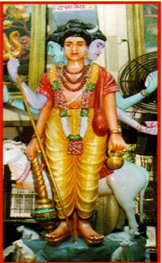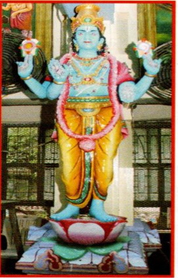Architectural The Side Pillars
ARCHITECTURAL BEAUTY IN THE SIDE PILLARS OF MAIN TEMPLE HALL
The Advaita Guru-Parampara begins with the Daiva-parampara (Narayana and Brahma) fllowed by Rishi-Parampara which includes the vedic seers Vasistha, his son Sakti, his son Parasara, his son Vyasa (the famour redactor of the Vedas, the composer of the Brahmasutras), and Vyasa’s son Suka. After Suka, we turn to the Manava-Paramapara, which brings us to historical times and personalities.
Narayanam padmabhuvam vasistham saktim cha tat-putram parasaram cha
Vyasam Sukam Gaudapada mahantam govinda yogindram athasya sishyam
Sri sankaracharyam athasya padmapadam cha hastamalakam cha sishyam
Tam trotakam vartikakaramanyan asmad gurun santatamanato smi
Dattatreta
Dattatreya, the Adiguru, encompasses the trinity of Brahma, Vishnu & Siva. The name Dattatreya can be divided into two words – “Datta” (meaning given) and “Atreya” referring to the sage Atri, his physical father. Spiritual seekers pray to this Supreme Teacher for knowledge of the Absolute Truth. Dattatreya is the author of Tripura Rahasya given to Parasurama, a treatise on Advaita Vedanta. He is specially worshipped on his birthday, Datta Jayanthi.
Dattatreya has six hands and whom lowest two hands have maalaa and kamandalu, middle pair of hands hold a damaru and trishool and top two hands have holy Shankh and Chakra indicating Brahma, Vishnu and Siva. Four dogs accompanied Dattatreya, who represented the four Vedas. Reference of Dattatreya is found in Mahabharata and Ramayana


Narayana
Narayana is the Supreme God in his infinite all pervading form is spoken of in the scriptures as being “parabrahman”, “paramatma’ and ‘parameshwar’. He is the Supreme Purusha of Purusha Sukta.
In the Narayana Suktam of the Vedas, it is written that the ‘Narayana parabrahman tatvam Narayana paraha’, which points to the how Narayana is essentially the supreme force and/or essence of all. ‘Antar Bahisca Sarvam Vyapta Narayana Stitaha’ means inside and out, Narayana is pervaded throughout the universe both spiritual and material universes. Everything emanates from Him. He Himself expands as Brahma the creator (Generator),Vishnu the maintainer (Operator) and Siva as the annihilator (Destroyer) – GOD. Whether you read Rig Veda or any other Vedas and Puranas it has said Lord Narayana is the supreme and there is absolutely
nothing beyond Him, it says in Srimad Bhagavatam Yesha tu Narayanam devam adevam isham (‘Narayan is the Lord of the Lords beyond him there is nothing exists’)
The universal form of Narayana is mentioned in the Maha Narayana Upanishad as “Om sahasra seersam devam vishwakhyam vishwa sambhubam, viswam Narayana devam aksharam paramam padam’ meaning, the universal form of Narayana has countless heads, eyes, limbs, and he is the indestructible seed whose feet are the ultimate shelter for all.
Narayana is also venerated as Mukunda, which means God who is giver of mukti or Moksha or liberation from cycle of births and deaths in the material world. Narayana’s eternal and supreme abode beyond the material universe is “Vaikuntha” which is realm of bliss and happiness. The word Vai-kuntam itself means to be rid of sadness caused by pair of opposites.
Padmabhuva
According to Srimad Bhagawata Mahapurana Brahma was born through the lotus created in Vishnu’s navel, thus getting the name ‘Padmabhuva’. Brahma is the God of creation. In the Ramanaya and Mahabharata, he is often referred to as the progenitor or great grandsire of all human beings. Brahma’s wife is Saraswati.
According to the Brahma Purana, He is the father of Manu, and from Manu all human beings have descended. He created from his mind, ten sons or Prajapatis, called Manas Putras or mind-sons.
He is with the Vedas which always existed from time immemorial, created the Universe. Brahma is traditionally depicted with four heads, four faces and four arms. With each head, He continually recites one of the four Vedas. He is often depicted with a white beard, indicating the nearly eternal nature of his existence. Unlike most other gods, Brahma holds no weapns. One of his hands hold a sceptor. Another of his hands holds a book. Brahma also holds a string of prayer beads called the ‘aksamala’ which He uses to keep track of the Universe’s time. He is also known holding the Vedas.

Humans should receive the blessings of Brahma and Saraswati, without which the populace would lack creativity, knowledge to solve mankind’s woes. The symbolic presentation of Brahma and inner implications are stated below :
The Four Faces – The Four Vedas (Rig, Yajur, Sama and Atharva)
The Four Hands – Brahma’s four arms represent the four cardinal directions – East, West, North and South. The back right hand represents the mind, the back left hand represents intellect, the front right hand represents the ego and the front left hand represents self-confidence.
The Prayer Beads – Symbolize the substances used in the process of creation.
The Book – Symbolizes knowledge.
The Gold – Symbolizes activity; the golden face of Brahma indicates that He is actively involved in the process of creating the Universe.
The Swan – Symbolizes grace and discernment. Brahma uses the swan as his vahana or carrier.
The Crown – Lord Brahma’s crown indicates His supreme authority.
The Lotus – Symbolizes nature and living essence of all things and beings in the Universe.
The Beard – Symbolizes wisdom and the eternal process of creation.
Lord Brahma’s day and night, each consists of 4.32 billion human years. After meditation Brahma created 14 planetary systems and many living beings came there in 8400000 kinds of material bodies according to their past desires.

Vashishta
Vashista is a manasputra of God Brahma. He had in his possession the divine cow Kamadhenu, and Nandini her child, who could grant anything to their owners. Arundhuti is wife of Vashista. Rig Veda mentions Vashistha Rishi as son of Mitravaruna and Urvasi.
Vashistha, is credited as the chief author of Mandala 7 of the Rig Veda. Vashistha and his family are glorified, extolling their role in the Battle of Ten Kings, making him the only moral besides Bhava to have a Rig Vedic hymn dedicated to him. Another treatise attributed to him is Vashishta Samhita – a book on the Vedic system of electional astrology.
The star Mizar is known as Vashistha and Alcor is known as Arundhuti in traditional Indian astronomy. The pair is considered to symbolize marriage (Vashistha and Arundhuti were a married couple) and, priests conducting a wedding ceremony allude to the constellations as a symbol of the closeness marriage brings to a couple.
He was the Guru of Lord Rama and he was also the Kula Guru of Surya Vamsam (Solar Dynasty). His dialogue with Rama on spiritual topics is a popular text called “Yoga Vasishtam”.
Sakti Maharishi
Sakti Maharishi was the son of Vasistha and father of Parasara. He was one among the Advaita Guru Parampara. His mother’s name was Adrishyanti.
He died at an early age and his son Maharishi Parasara, Maharishi Saraswat and Maharishi Galav was raised by his father Vasistha. Shakti Muni was on a journey and came across an angry Rakshasa, who had once been a king but was turned into a demon feeding on human flesh, by Vishwamitra. The demon devoured him.


Parasara
Parasara to avenge the death of his father killed many rakshasas. His grandfather Vasishta, then stopped him by advising him that sages shun wrath and covet mercifulness.
Parasara Muni (Sage), on one of his travels across the country, halted for the night in a little hamlet on the banks of the river Yamuna. He was put up in the house of the village chief. When dawn broke, the chief asked his daughter, Satyavati, to ferry the sage to his next destination. When in the ferry, Parasara was offended by the stench of raw fish. He asked Satyavati as to from where the foul stench was emanating. Satyavati was a firsherman’s daughter, and pursued the same occupation. It was from her the
Veda Vyasa
Veda Vyasa is an incarnation of Lord Vishnu, is the author of Mahabharata, as well as a character in it and is considered to be the scribe of both the Vedas and Puranas. Guru Purnima is dedicated to him and is also called ‘Vyasa Pournima’. Veda Vyasa categorized Vedas fourfold to ensure continued study and protection of it by generations to come. Vyasa fathers the princes Dhritarashtra and Pandu and Vidura by Niyoga method. His son Sukawas born of his wife, sage Jabali’s daughter Pinjala (Vatika).
In the first book of Mahabharata, it is described that Vyasa asked Ganesha to aid him in writing the test, however Ganesa imposed a condition that he would do so only if Vyasa narrated the story without a pause. To which Vyasa then made a counter-condition that Ganesha must understand the verse before he transcribed it. Thus Vyasa narrated the entire Mahabharata and all the Upanishads and the 18 Puranas, while Lord Ganesha wrote. He also authored the Brahma Sutras, the epitome of Vedantic texts.
Amongst the principal works of Adi Sankara are the commentaries he has written for Bhagavad Gita and Brahma Sutras authored by Veda Vyasa.


Sri Sukha
Stories recount Sukha’s purity and disassociation with body was such that, even when he passed by bathing girls, they did not come to awareness of their bodies. The Devi Bhagavata accounts how Sukha was sent by Vyasa for training to King Janaka, who was considered to be a Jivanmukta, or one who is liberated while still in a body. Taking his advice, Sri Sukhar married Pivari and had four sons and a daughter. Towards his end, he went to meditate at Kailash. He taught Mahabharata to Gandharvas, Yakshas and Rakshasas.
Gaudapada
Gaudapada authored detailed karakas for Mandukya Upanishad. The Gaudapadiya Karika is divided into four chapter – Agama Prakarana, Vaitathya, Advaita Prakarana and Alatasanti Prakarana.
Adi Sankara at the end of his famour commentary to the Gaudapada Karika – addresses the following salutations to Gaudapadacharya as his “Parama Guru” and compliments Him for recovering Advaita Siddhanta from Vedas.


Govinda Bhagavad Pada
Sri Gaudapadacharya from his power of Tapasya found out that Sri Sankara was an incarnation of Lord Siva and born to uplift the Vedas and thus Sanatana Dharma and instructs his Sishya Sri Govinda Bhagavadpadacharya to give Deeksha to Sri Sankara and
later Govinda Bhagavadapadacharya initiated Sri Sankara into Sanyasa and named him as Sri Sankara Bhagavatpadacharya. After giving Deeksha Sri Govinda Bhagavadapadacharya instructed Sri Sankara to write a commentary on the Brahma Sutras and propagate the Advaita philosophy. Sri Sankara stayed with his Guru for some more years and mastered the Vedanta.
The Madhaviya Shankara Vijaya states that Adi Sankara once calmed a flood from the Reva river by placing his kamandalu (water pot) in the path of the raging water, thus saving his Guru Govinda Bhagavadapadacharya who was immersed in Samadhi in a cave nearby.
Sri Govinda Bhagavadapadacharya also gave Deeksha to another vatu and named him Sri Vivarananda, who returned to head Sri Gaudapadacharya’s Matha at Keloshi in Goa.
This accounts for Guru Parampara of Sri Adi Sankaracharya.
Sadashiva Samarambham Shankaracharya Madhyamam
Asmadacharya Parayantam Vande Guru Paramparam.
Salutation to the lineage starting with Lord Sadasiva, with Adi Sankara in the middle and continuing up to my immediate teacher.
